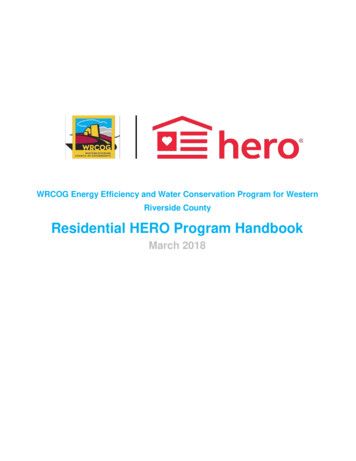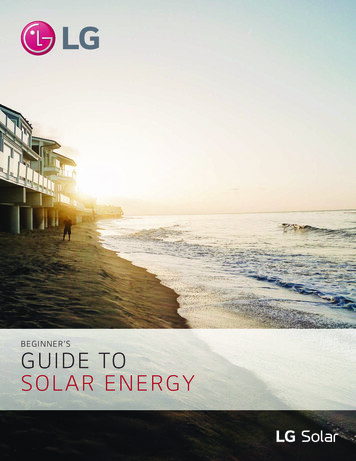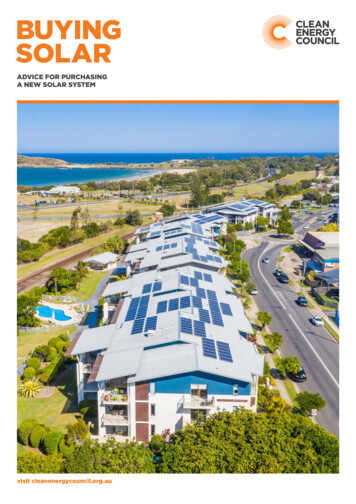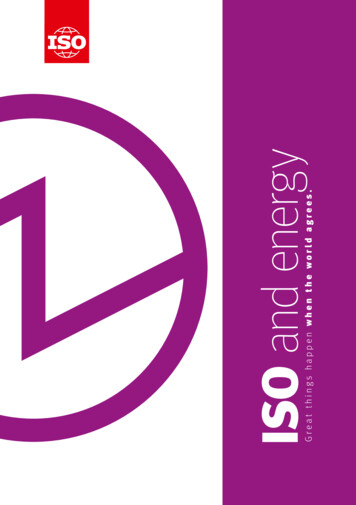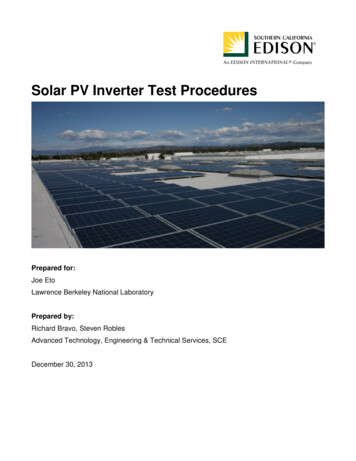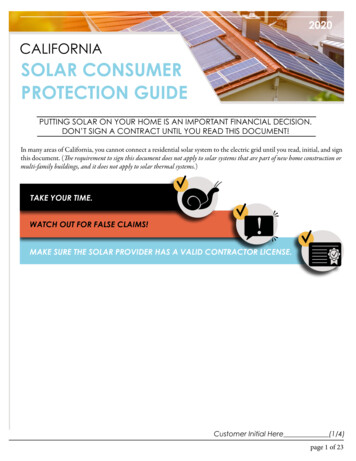
Transcription
2020CALIFORNIASOLAR CONSUMERPROTECTION GUIDEPUTTING SOLAR ON YOUR HOME IS AN IMPORTANT FINANCIAL DECISION.DON’T SIGN A CONTRACT UNTIL YOU READ THIS DOCUMENT!In many areas of California, you cannot connect a residential solar system to the electric grid until you read, initial, and signthis document. (The requirement to sign this document does not apply to solar systems that are part of new home construction ormulti-family buildings, and it does not apply to solar thermal systems.)TAKE YOUR TIME.WATCH OUT FOR FALSE CLAIMS!MAKE SURE THE SOLAR PROVIDER HAS A VALID CONTRACTOR LICENSE.Customer Initial Here (1/4)page 1 of 23
MAKE SURE TO READ AT LEASTTHE NEXT 3 PAGESIf you are considering signing a contract for aresidential solar system.Most solar providers are honest and fair. However, there are still some false claims you need to watch out for. Do not dobusiness with a salesperson that makes one of these false claims.False claims towatch out forThe TruthFALSEYou can get free solarenergy at no cost toyou.TRUEFALSEYou will never pay anelectricity bill everagain after a solarsystem is installed.TRUEFALSETime is running outand you must quicklysign an electronic tabletto get solar.TRUESolar energy is rarely free. An honest company willbe upfront about all the costs you will pay over time. There is one exception: a few governmentfunded solar programs offer free or low-costsolar to low-income households. Go directlyto page 6 to see what government-approvedorganizations run these programs.After going solar, you will typically pay a smallelectricity bill every month and a larger electricity billat the end of the 12-month cycle, depending on theutility billing rate. See page 17 for an example. Customers who take out a solar loan or sign a leaseor power purchase agreement will also receive amonthly bill from a loan company or solar provider. If you use PACE (Property Assessed Clean Energy)financing, you will also make a payment once ortwice a year with your property taxes or monthlywith your mortgage payment.An honest salesperson would never rush you to signanything without giving you time to review what youare signing. California law requires that a salesperson showyou the contract terms before you sign.Customer Initial Here (2/4)page 2 of 23
Know Your RightsYOU HAVE THE RIGHT.YOU HAVE THE RIGHT.to a copy of a solar contractand financing agreement inthe language in which thesalesperson spoke to you.to read this entire 23-pageguide before signing acontract.If a solar provider comes to your home to sell you solar panels andspeaks to you in a language other than English (such as Spanish),you have the right to a copy of the contract in that language.Do not feel pressured to read this guide while thesalesperson waits. Ask them to come back at a later date toallow you time to read it.If you are a public utility customer, a solar provider mustgive you the time to read and sign this guide before you signa contract for solar. If they do not allow you to read thisdocument, they should not be allowed to interconnect yoursolar system to the electric grid.YOU HAVE THE RIGHT.YOU HAVE THE RIGHT.to a Solar DisclosureDocument from yoursolar provider.to a 3-day cancellation periodafter signing a contract.By law, a solar provider must provide you with a completedSolar Energy System Disclosure Document created by theContractors State License Board (CSLB). This one pagedocument shows you the total costs for the solar energysystem. A blank version of this document is available atwww.cslb.ca.gov/contractors/SolarSheet.aspx.You have at least three business days to cancel your contractfor any reason. You may cancel the contract by emailing,mailing, faxing, or delivering a notice to your solar provider bymidnight of the third business day after you received a signed,dated copy of the contract. Note that different rules may applyfor contracts negotiated by a company’s place of business.If your solar provider refuses to cancel the contract, reportthem to the Contractors State License Board at800-321-CSLB(2751) or www.cslb.ca.gov/consumers.Customer Initial Here (3/4)page 3 of 23
Ask a Solar Provider These Initial QuestionsBefore You Sign a Contract?What is your Contractors State License Board (CSLB)license number?Ask for a proof of the license. Then check the license to make sure it is valid by going towww.cslb.ca.gov/consumers or calling 800-321-CSLB (2752). The license must be active and in classification A (General EngineeringContractor), c-46 (Solar Contractor), C-10 (Electrical Contractor), or B(General Building Contractor) in order to be valid. CSLB License Number is:If your solar provider does not have a valid contractor license, do not sign a contractwith them and report them to the CSLB.?What is the total cost of the solar energy system?If you are considering a solar loan, lease, or power purchase agreement, also ask: Is there a down payment? How much will I pay per month? When will these payments increase andby how much?If you are considering PACE financing, also ask: ?How much will I pay once or twice a year with my property taxes ormonthly with my mortgage?If I sell my home, what are my options and what do Ineed to do?Ask your solar provider, lender, or PACE administrator to show you where in thecontract it describes what happens when you sell your home.For other important questions to ask a solar provider before you sign a contract,go to page 10 of this guide.Ok, I read these 3 pages. Now What? For a step-by-step guide for how to go solar, proceed to the next page. This isrecommended, even if you’ve already started the solar process! If you are getting ready to sign a contract, skip to the “Before You Sign” checklist, onpage 22 of this guide.Make sureto get 3 bids fromdifferent solar providersbefore you sign a contract.See page 9 of this guidefor more details.Customer Initial Here (4/4)page 4 of 23
ROAD MAP FOR SOLAR AT YOUR HOME1Is Solar aGood Fit forMe?FindQualified SolarProviderLearn AboutElectricity BillSavings“Before You Sign”Checklist13572468UnderstandRoles & SolarProcessCompareFinancingOptionsCarefullyRead AllPaperworkSign ThisGuideSTEP 1: Is Solar a Good Fit for Me?Solar photo-voltaic panels can capture sunlight on your roof or property and convert it into electricity.This electricity powers the needs of your home, such as lights, electric vehicles, and appliances.Before you consider getting solar at your home, ask yourself:?Do I qualify for low-income solar programs?If you think you might qualify for a low-income solar program, go directly to the next page(page 6).?Am I a good candidate for rooftop solar? Does my roof receive a good amount of sunlight or is it mostly shaded? What directiondoes the roof face? Roofs that are mostly shaded or face due north are not goodcandidates for solar. If you plan to replace your roof soon, you should replace it beforeinstalling a rooftop solar system. If your roof is heavily shaded or isn’t in great condition, or if you are a renter,community solar programs could be a good fit for your. With community solar, youreceive 50-100 percent of your electricity from solar projects located across California.Community solar programs vary and may increase your electricity bill or provide anelectricity bill savings. Contact your electricity provider for more information.?Have I made my home energy efficient first?Making your home energy efficient before going solar can decrease your overall energyuse and reduce the size of the solar system you need, potentially saving you thousands ofdollars. Call your electricity provider or check their website for energy efficiency tips andadvice on how to get an in-person home energy assessment.page 5 of 23
Low-Income Solar ProgramsConnect With Your Local Utility.GRID ALTERNATIVES AND DAC PROGRAMGRID Alternatives, a non-profit organization, offers assistance for certain incomequalified solar programs in some local jurisdictions and Disadvantaged Communities.Contact GRID Alternatives by visiting www.gridalternatives.org/qualify or bycalling 1-866-921-4696.*A DAC is a neighborhood vulnerable to multiple sources of pollution. To find out if you livein a qualified DAC, check out the map at: TY SOLAR PROGRAMSCommunity Solar Programs allow qualifying households to subscribe to a utility-owned solar project. Theseprograms vary with each public utility so check with your electric provider to get more information regarding acommunity solar program.iIf you are a public utility customer, call your electricity provider or check their website to see if anylow-income solar options are available to you.page 6 of 23
2STEP 2: Understand Roles and Solar ProcessSolar ProvidersSolar providers are the companies thatsell you solar and send installers toyour home. Sometimes they providefinancing. They must be licensed. Seepage lers are sent by Solar Providers toyour home to check roof, ground andelectric conditions and to install thesolar system. They must be licensed likea Solar Provider. See page 4.City orSalespeopleSalespeople work for Solar Providersand may call you or knock on yourdoor. They must be registered, withsome limited exceptions. Ask for their“Home Improvement Salesperson(HIS) registration” and check it at 800321-CSLB (2752) or nstallersLendersLenders provide you with financing if you have a solar loan or PACE financing.PACE AdministratorsPACE administrators manage PACE financing programs. They must be licensed. Check their license at ty ProvidersElectricity providers interconnect your solar system to the electric grid and send you electricity bills that may include solarbill credits.ManufacturersManufacturers are the companies who make solar equipment. They provide most solar warranties for purchased systems.City/Utility InspectorsCity/utility inspectors come to your home to make sure the system is up to code to ensure your health and safety.page 7 of 23
Overview of a Typical Rooftop Solar ProcessBEFORE YOU SIGN A CONTRACTYou .You .You .You .Solar Provider.You .Lender.You .You .You .decide if rooftop solar is a good fit for you (see page 5)get a home energy assessment to make your home more energy efficient (see page 5)look at low-income solar programs to see if you qualify (see page 6)research Solar Providers and compare at least 3 bids(see page 9)provides you with solar contract, Solar Disclosure Document, and this Solar Consumer Guidequalify for financing (if needed)writes up financing agreement (if needed)review solar contract, Solar Disclosure Document, and any financing agreement (see page 19)go through checklist on page 22 of this Solar Consumer Guidesign this Solar Consumer Guide, solar contract, and financing agreementAFTER YOU SIGN A CONTRACTInstaller . performs a home site visit to confirm assumptions and check roof, ground, andelectric conditionsSolar Provider . finalizes system design and applies for building permit with city or country agencyInstaller . installs the solar system (only after receiving city/county permit)City/Utility Inspector . inspects system for building permit complianceSolar Provider . submits application to electricity provider to interconnect solar system to gridSolar Provider . submits city/county inspection approval to electricity providerYou . turn on system after receiving written approval from electricity providerElectricity Provider . sends you your first electricity bill with solar/net energy metering credits (see page 17)Lender/Solar Provider . sends you first bill for solar system or solar energy**IF YOU USE PACE FINANCING,you will not receive a bill from a Lender orSolar Provider (the last step above). Insteadyour payments will be due once or twice ayear with your property taxes or monthlywith your mortgage payment.It typically takes 1 to 3 months after you sign acontract for the solar system to be installed at yourhome.After the solar system is installed, it typically takes2-3 weeks to receive approval from your electricityprovider to turn your system on. It could takelonger depending on your circumstances.page 8 of 23
3STEP 3: Find a Qualified Solar ProviderFIND PROVIDERFind Solar Providers that Serve Your NeighborhoodGo to www.cslb.ca.gov, a government website, and click on the “Find My Licensed Contractor” search onthe right-hand side of the page. Enter your city and one of the following license classifications: C-46 (SolarContractor), C-10 (Electrical Contractor), or B (General Building Contractor).Go to www.CaliforniaDGStats.ca.gov, a government-funded website, to enter your zip code and see a listof Solar Providers and recent installation costs. Note that these costs are not verified by the government.Go to www.energysage.com to research and shop for solar, financing, and energy efficiency options.Ask friends and neighbors who had solar installed at least a year ago if they recommended a Solar Providerand why.NARROW DOWNNarrow Down the List to Qualified Solar ProvidersFirst, make sure Solar Providers you consider have a valid license from the CSLB. It is illegal for SolarProviders and their Installers to conduct business without a license. Go to the Contractors State License Board (CSLB) website at www.cslb.ca.gov/consumers or call800-321-CLSB (2752) to see if the Solar Provider and Installer licenses are active and valid. Thelicenses must be in the classifications: C-46 (Solar Contractor), C-10 (Electrical Contractor), B(General Building Contractor), or A (General Engineering Contractor).Find out how long the company has been in business and how many installations they have done.Check out trusted customer review websites online. Since some websites may not be neutral, check a fewdifferent websites to make sure reviews are consistent.It’s a good sign if companies employ installers certified by the North American Board of Certified EnergyPractitioners (NABCEP), a high standard in the industry.GET BIDSGet Bids From At Least 3 Qualified Solar Providers and Ask QuestionsAfter you narrow down the list of Solar Providers, separately ask each of them for a bid or price quote. Note that the best option for you is not necessarily the cheapest bid. A very low bid may indicate thata Solar Provider is trying to cut corners.Don’t hesitate to ask Solar Providers a lot of questions up front. A qualified company will be happy to answerall of them. A sample list of questions in on the next page.page 9 of 23
?Questions to Ask a Solar ProviderBefore You Sign a ContractCOMPANY BACKGROUNDWhat is your company’s contractor license number from the Contractors State LicenseBoard (CSLB)? What is your Installer’s contractor license number?Will you subcontract with another company to install the solar system? If so, what istheir CSLB contractor license number?How long have you been in business and how many systems have you installed?Can you provide me with three customer references to call or visit? These customersshould have solar installed for at least a year.DESIGN & ROOFIs my roof a good candidate for solar? Why?Does my roof need to be replaced before installing solar panels? If yes, how much will that cost, who will do it, what is their license number, and isthere a roof warranty?Why did you choose this specific design and size for the solar system you arerecommending to me? Note that a system sized to cover all of your electricity needs isn’t necessarilythe best investment. Typically, a system is sized to around 80-85 percent of yourelectricity use from the previous year.What steps will you take to ensure my roof won’t leak?Roughly how much will it cost to remove and re-install the panels if I need to replace myroof in the future, including inspection fees?WARRANTIES & PERFORMANCE OF SOLAR SYSTEMAre there warranties for the panels and inverters? If yes, how long do they last and who do I contact to replace these components? If equipment such as the inverter fails after the warranty period, how much willit cost to replace?Are there warranties for labor/construction?Are repairs and maintenance included in the contract? If yes, who should I contactfor repairs?Will I be able to monitor the performance of the system once it’s installed? If so, how?Does the solar provider offer a minimum energy guarantee (common with leases andpower purchase agreements)? If yes, how will I be paid if the system does not produce as much energy aspromised in the contract?page 10 of 23
Is there an insurance policy that comes with the solar system, or do I need to take outadditional homeowner’s insurance? Note that this is especially important if you live infire-prone areas.What are my obligations in the contract if my solar system stops working due to a disasterlike an earthquake or a fire?Who has the right to claim the environmental benefits of the power generated by mysystem? (See “Getting Environmental Credit for Going Green” on page 18).ELECTRICITY BILL SAVINGS ESTIMATE (see page 17)information on false claims.Explain to me why an electricity bill savings estimate is not a guarantee.Even though I will continue to pay electricity bills after going solar, I can receive solar billcredits on my electricity bill. How does that work?Is there an option to pay my electricity bills monthly instead of annually, so the costs aremore even throughout the year? How do I sign up?What electricity rate do you recommend I switch to for solar, and why?How long will I be on that rate, and how can I compare or change rates on my electricityprovider’s website?Does my electricity provider offer special rates for solar customers?IMPACTS ON FUTURE SALE OF YOUR HOMEWill a solar system make it more difficult for me to sell my home or refinance?For leases, power purchase agreements (PPAs), and PACE financed systems: What happens if the home buyer doesn’t want the solar system or doesn’t qualifyto take on my lease, PPA, or PACE financed system? Are there fees if I need to terminate the contract early to sell my house? Are there fees for transferring the lease PPA, or PACE financing to a newhomeowner?TIMELINE (see page 8)REMBENOV14When do you propose to start and finish installing solar on my roof ?After installation is complete, roughly how long will it take for my electricity provider tosend me written approval to turn my system on?What situations would allow me to be released from a contract?Do you want to know questions to ask about loans or financing?Keep reading because those are in the next sections!page 11 of 23
4STEP 4: Compare Your Financing OptionsMostCommonSolar FinancingOptionsPurchase(Cash or Side-By-Side Quick Financial ComparisonPROSPurchase with Cashor Loan Typically greater return on investment. If you use a loan, little or no upfrontcosts. May increase value of home. You can directly receive tax credits anddeductions. Consult tax professionalto see if you qualify.CONS You are typically responsible forrepairs and maintenance. Thismay involve contacting differentmanufacturers, who could go outof business during the 10-20 yearcomponent life cycles. Some solar loans place a lien on yourproperty. In those cases, if you donot make your payments, this couldresult in foreclosure or make it moredifficult to sell your home or refinanceyour mortgage.page 12 of 23
PROSCONS Little or no upfront costs. May have a longer repayment period thantypical home improvement loan, whichmay be preferable.PACE Financing You may be able to receive tax credits anddeductions. Consult tax professional tosee if you qualify. Little or no upfront costs. Solar Provider is responsible forall monitoring, maintenance, andrepairs. Minimum energy production oftenguaranteed.Lease and PPAA Closer Look at Purchase PACE financing results in first-prioritylien on your property. Your bankmay require you to pay off the PACEassessment prior to refinancing. If you do not make your PACE payments,this could result in foreclosure or makeit more difficult to sell your home orrefinance your mortgage. You are typically responsible for repairsand maintenance. This may involvecontacting different manufacturers, whocould go out of business during the 10-20year component life cycles. Selling home may be more complicatedthan with a purchase system. Optionstypically are: the new owner must agreeto take on the lease/agreement, youcontinue making payments, or you buyout the lease/agreement, which could bethousands of dollars. Solar Provider could go out of businessduring the contract period.(with cash or loan)PURCHASEYou can purchase a solar system from a Solar Provider or Manufacturer with a solar loan or cash. Inthis approach, you own the installed system. Types of loans include: Secured loans: these require an asset that will serve as collateral for the loan - often thatasset is your solar system.Unsecured loans: these do not require any collateral, similar to a credit card.A secured loan is often preferred because it typically has lower interest rates.Many Solar Providers work with lenders that offer solar loans, but you should check with banks andcredit unions as well. Compare offers to make sure you are being offered a reasonable interest rate.page 13 of 23
PURCHASEIf you install and own a solar system by the end of 2020, there is supposed to be a 26 percent federaltax credit available (also referred to as the “ITC”). The federal tax credit is expected to drop to 22percent for systems installed in 2021, and then drop to 0 percent for systems installed after 2021. Ifyou have questions about the ITC please contact the Internal Revenue Service athttps://www.irs.gov/ or any other questions, including whether a loan is tax deductible, pleasespeak to a Certified Public Accountant (CPA) for personal tax advice.Unless you purchase a maintenance plan or your system comes with one, you will be responsiblefor any maintenance and repairs. Make sure you save the equipment warranties, particularly for theinverter, which may need to be replaced sooner than other equipment. If you sell your home, lookfor real estate agents and appraisers with experience selling homes with solar. You may include thesystem in the house sale just like any other major home component.?Questions to Ask a Lender About thePurchase of a Solar System with a Loan:?What is the total cost of the loan over the entire course of the contract?How much will I pay up front, how much over time, and for how long?What is my interest rate? What is my annual percentage rate (“APR”)?Who do I contact if I have questions about my loan payments?Will a solar loan make it more difficult for me to sell or refinance my home? Will I needto buyout my loan? Who do I contact?PACE(Property Assessed Clean Energy)A Closer Look at PACE(Property Assessed Clean Energy)PACE is a financing option that is available in some areas of California. In a PACE financingarrangement, a PACE Program Administrator finances the upfront costs of a solar system, whichyou then pay through an assessment on your property tax bill. With PACE financing, you own thesolar system.PACE financing lasts for a fixed term, typically around 10-30 years, and it is attached to your house.If you sell your house before you have fully paid the PACE assessment, a buyer may require you topay off the assessment, which will be what is remaining in the balance, which could be thousands ofdollars. Some mortgage lenders will not loan money to buyers to purchase properties with PACEliens unless the full assessment is paid.Unlike Leases and Power Purchase Agreements that require monthly payments, PACE assessmentsare typically due once or twice a year, in larger lump sums, with your property taxes. Given thisunique arrangement, it’s important to understand how much you will owe and when, so that youcan set aside enough money throughout the year to cover the amount.If your house is mortgaged and you typically pay your taxes with an escrow or impound account,your mortgage company may increase the amount you pay monthly to (continued on next page)page 14 of 23
PACE (cont.)cover the anticipated increase to your property tax bill. Discuss how PACE will affect your monthlymortgage payment before you sign an agreement.Be aware that if you fail to make your PACE payments included with your property taxes ormortgage, your home could be put in foreclosure.?Questions to Ask a PACE Program AdministratorAbout a PACE Financed System:?What is the total cost of the financing over the entire course of the contract?How much will I owe for PACE financing when I pay my mortgage or property taxes?How many times a year will I owe this PACE payment?What happens if I want to sell or refinance my home? Will selling or refinancing be moredifficult with PACE? Is there anything I have to do with the mortgage company?What are the penalties for failing to pay the assessment on time?Who do I contact if I have problems making my PACE payments?LEASE ANDPOWER PURCHASE AGREEMENTA Closer Look at Lease and PPA(Power Purchase Agreement)With a Lease, the Solar Provider owns the system on your property and “rents“ it to you for a setperiod of time. A Solar Provider will install the solar system on your home, and you will makescheduled monthly payments in exchange for all the electricity the system produces. A typical Leasecontract period is 20-25 years.In a Power Purchase Agreement (PPA), the Solar Provider owns the system on your property andsells you the electricity it generates. PPAs are similar to Leases, except that instead of making a fixedmonthly payment for the system, you typically pay for all the power the solar system generates (afixed per-kilowatt-hour rate). The contract will specify the kilowatt-hour rate you pay in the firstyear and every year after that. This rate should generally be lower than your current electricity rate.A typical PPA contract period is 20-25 years. If you sell your house before the Lease or PPA contract is over, you will have to pay the SolarProvider the remainder of the value of the Lease or PPA or transfer the contract to the newproperty owner. Make sure you understand the specific contract terms, since buying out aLease or PPA can cost thousands of dollars.Payments for Leases or PPAs will typically increase by a specified amount every year basedon an “escalation clause” or “escalator.” Escalators are typically in the range of a 1 percent to3 percent increase above the rate you paid in the previous year. Be cautious of entering into acontract with an escalator higher than that.There may be different ways to arrange Leases and PPAs, such as paying more up front toreduce your monthly payments.page 15 of 23
?Questions to Ask a Lender or SolarProvider About a Lease or PPA?What is the total cost of the solar system or solar energy over the entire course of thecontract?How much will I pay up front, how much over time, and for how long?Will my payments increase over time? How much will they increase, and howfrequently?Is there an option to make a down payment to reduce my monthly payments (for a Lease)or kilowatt-hour rate (for a PPA)?What happens if I wish to end the Lease or PPA early?If I end my agreement early, will I owe a balloon payment and/or an early termination fee?If so, how much will I owe?Will a Lease or PPA make it more difficult for me to sell or refinance my home?5STEP 5: Learn About Electricity Bill SavingsElectricity Bill Savings Estimates Do Not Guarantee SavingsAn electricity bill savings estimate is an educated guess about how much you could save with rooftop solar. Here aresome reasons why it’s possible that your savings could be lower than the estimate:Electricity bill savings estimatesare based on several uncertainfactors, such as your future energyuse. For example, if your familygrows, you buy an electric vehicle,or you decide to turn up your airconditioning in the summer, yourenergy use will go up along withyour electricity bill.Electricity prices and rates canchange over time. Your electricityprovider may require you to switchto a different rate in the future,which could change how muchyou save.If you sell your home, you couldincur additional costs. Forexample, if a buyer doesn’t want totake on a Lease or Power PurchaseAgreement, you might have to buyout the contract, which could bethousands of dollars.Before you sign a contract, ask yourself: if the savings end up being lower than the estimated monthly or yearlysavings, does getting rooftop solar still make sense to me?page 16 of 23
HOW ELECTRICITY BILL SAVINGS WORKThere is a special arrangement with your electricity provider that is called Net Energy Metering (NEM). NEM allowsyou to get a financial credit on your electricity bill when your solar system sends electricity back to the grid after firstpowering the electricity needs at your house. This credit is sometimes equal to the retail rate of energy and sometimesequal to the wholesale rate, depending upon the utility.NEM and Your Electricity BillSince the sun isn’t always shining, solar customers also rely on electricity from their electricity provider.After your solar system is interconnected to the grid, your monthly electricity bill will summarize how muchelectricity you took in or “consumed,” from your electricity provider, and how much electricity your solarsystem sent to the grid or “exported.”If you took in more than you sent out to the grid in any given month, you will see an overall
community solar programs could be a good fit for your. With community solar, you receive 50-100 percent of your electricity from solar projects located across California. Community solar programs vary and may increase your electricity bill or provide an electricity bill savings




